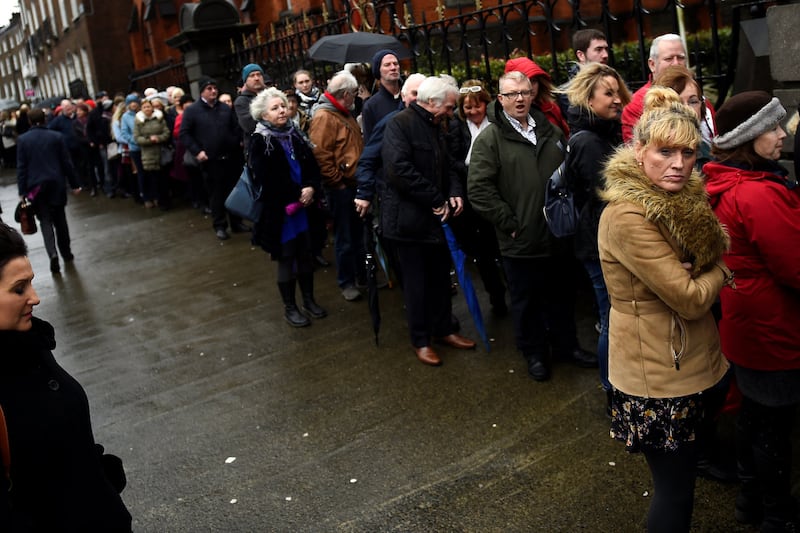About six or seven years ago, something strange started happening with a particular song. Good songs are built to last. Dreams by The Cranberries is one of those songs. Linger was coming back too. Zombie never really went away, particularly in karaoke bars. But Dreams? Dreams started hanging around more.
It was as if the song itself, released in 1992, was tapping a mic to see if the thing was still on. When the trailer for Lisa McGee’s series Derry Girls aired in late 2017, Dreams was there in the promo. The song was firmly back in the collective consciousness. It’s a song that doesn’t so much cause hairs to stand on the back of your neck, as to beckon them to attention.

In Derry Girls, the song was a madeleine moment. It had the Proust effect. We were all, gradually and then suddenly, in search of lost time. By the time the final episode of that first series aired, in February 2018, with Dreams ringing out over a sequence juxtaposing youthful exuberance with unspeakable tragedy, Dolores O’Riordan was gone. She died in a hotel room in London. “It’s never quite as it seems, never quite as it seems.”
How did she do it? Well, it’s authentic emotion, isn’t it? Songs sung with intention. Lyrics from the heart. Craft
It’s five years since the Limerick native’s death, an ending to a life of huge creative success and acclaim, a tragic, sudden, premature loss of a talent so robust that it’s painful now to think of her vulnerabilities. When I wrote about her death for the New York Times at the time, I cited how small she always looked behind those large guitars she played. Really, they were just guitars, and she was just tiny, a contrast that made sense: human fragility behind the protection of a big instrument. There was, of course, a bigger one within her.
Competitive parenting in China: ‘School starts at 7.30am and I pick him up at 9.30pm. He studies again when we arrive home’
Ballrooms of romance: ‘I wasn’t the greatest dancer but when we danced together it was like it was meant to be’
After Storm Éowyn, Ireland must do what Sweden did 20 years ago
Signals coming from Trumpland could hardly be worse for Ireland and its economy
Listening to The Cranberries now, the quality of their songs’ production holds up so well. They have undeniable songs. All through the crunching guitars, or delicate riffs, or drum patterns, or the bass lines that rumble along, is O’Riordan’s voice. It has often been described as soaring, but, really it swoops in the quiet-loud tradition of 1990s radio-rock, where a cliff-dive into the fuzz was never too far away. That alt-rock sound was sometimes derided at the time, seen as derivative of grunge, the grime polished to reveal something gleaming. Music fandom is an inherently snobbish sport – what is popular, epic, forceful, intentional, is always resisted.
But within the songs, O’Riordan’s vocal was like both architecture and construction in motion simultaneously, the scaffolding being erected at the outset of a track, before a sort of step-back occurred, and suddenly a temple of sound was there for all to see. How did she do it? Well, it’s authentic emotion, isn’t it? Songs sung with intention. Lyrics from the heart. Craft.
But why was The Cranberries music coming back at the time? Dreams and Linger were finding their way back into our bodies, our lungs, our minds. During the recession, DJing in clubs and warehouse parties, it was always my preference to find songs at the edge of what memory was about to file away, and pull them back into the room. This is something that we do collectively, too. When things slip slightly from the consciousness, but are not so far gone as to be vintage or classic, quality tunes have a way of gripping on to the edge, and gradually, people give them a hand back up. They’re looking for us.
[ ‘She was on a roll’: The Cranberries on the last days of Dolores O’RiordanOpens in new window ]
[ The young Dolores O’Riordan: ‘Shy and wild, then that voice would explode’Opens in new window ]
And there’s a sort of virility to this stuff. People hear an oldish track in a club, and they play it at home, then their mate plays it in her set, then it hops into another club, it might drop in on a radio show, you find yourself listening to it at regular intervals. And then it’s everywhere. This is why at various stages over the past decade and a half or so, it has often felt as though suddenly everyone made a collective bargain to be into Abba songs in clubs again.

There are three kinds of tracks played in rooms that always conjure what Émile Durkheim called collective effervescence. One is the track that’s just breaking at the time. There’s a huge sense of exhilaration in a room when you play a track that’s going to be large, but the crest of its wave has yet to crash on the shore of repetition. The other is the tune that no one knows, something obscure but quality – new or not so new – that also just happens to be great, and you’re introducing it to people who get it immediately. Then there’s the type of track that’s at the back of the mind’s cabinet – not yet confined to the attic, but one your memory has allowed some dust to settle on. A DJ that’s tapped into what you want to hear before you even know you want to hear it can blow the dust off it, and bring you back to a place, a time, a feeling.
‘And now I tell you openly, you have my heart so don’t hurt me.’ What a wonderful, beautiful, direct lyric
It could also be the 20-year rule, the concept that something popular now will be popular 20 years from now, and therefore elements of what’s currently popular are actually things from 20 years ago. This cyclical phenomenon in pop culture trends rings true for fashion, for music, for design.
[ The Cranberries: In the End review – Dolores O’Riordan’s remarkable swansongOpens in new window ]
Maybe that’s what was happening with Dreams. The thing about the staying power of The Cranberries’ music and Dolores O’Riordan especially, is that her legacy hasn’t even played out yet. The year O’Riordan died, of course Limerick had to go and win the Liam MacCarthy Cup, becoming All-Ireland hurling champions. Again, Dreams was there, flowing through the stadium. And then in 2020, when the extraordinary collective of musicians, Irish Women In Harmony, coalesced, it was Dreams that they sang.

What makes O’Riordan’s voice, her lyrics, and her performances on record so enduring? Maybe it’s ultimately about vulnerability. She sings it in Dreams, “And now I tell you openly, you have my heart so don’t hurt me.” What a wonderful, beautiful, direct lyric. There it is, all of it, laid out. It takes a lot of distillation to get to that clarity. Many songwriters will often tell you they wrote some of their biggest songs in a matter of minutes, in a half an hour. But that’s the flow following the percolation. It’s a thought, a sentiment, a subject matter, a theme, all the accumulating emotions of life turned outward as a creative act. It’s something that doesn’t stop, even when the author’s spirit has departed, into some other dimension, some other dream.















